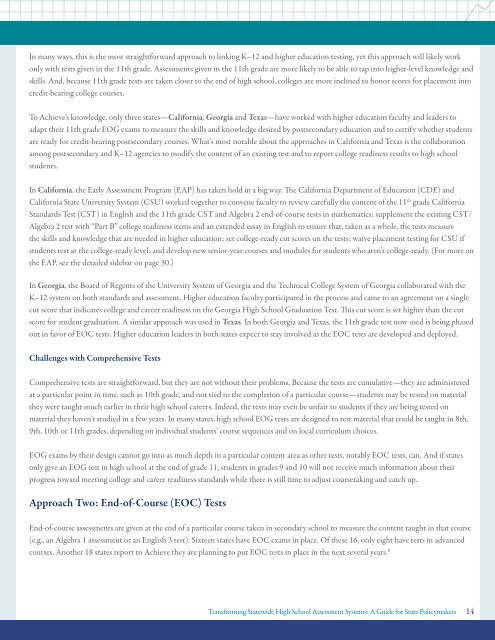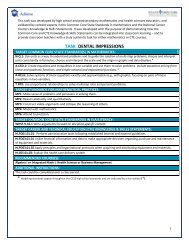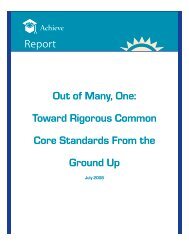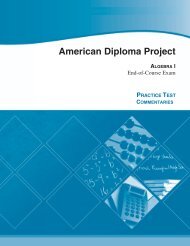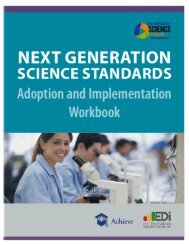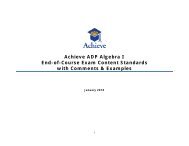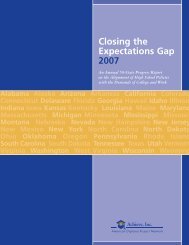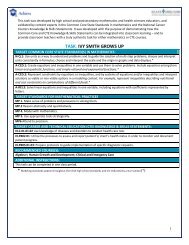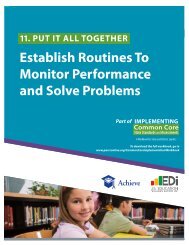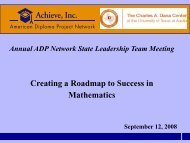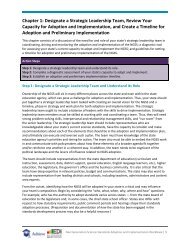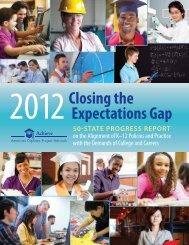Transforming Statewide High School Assessment Systems: - Achieve
Transforming Statewide High School Assessment Systems: - Achieve
Transforming Statewide High School Assessment Systems: - Achieve
Create successful ePaper yourself
Turn your PDF publications into a flip-book with our unique Google optimized e-Paper software.
In many ways, this is the most straightforward approach to linking K–12 and higher education testing, yet this approach will likely workonly with tests given in the 11th grade. <strong>Assessment</strong>s given in the 11th grade are more likely to be able to tap into higher-level knowledge andskills. And, because 11th grade tests are taken closer to the end of high school, colleges are more inclined to honor scores for placement intocredit-bearing college courses.To <strong>Achieve</strong>’s knowledge, only three states—California, Georgia and Texas—have worked with higher education faculty and leaders toadapt their 11th grade EOG exams to measure the skills and knowledge desired by postsecondary education and to certify whether studentsare ready for credit-bearing postsecondary courses. What’s most notable about the approaches in California and Texas is the collaborationamong postsecondary and K–12 agencies to modify the content of an existing test and to report college readiness results to high schoolstudents.In California, the Early <strong>Assessment</strong> Program (EAP) has taken hold in a big way. The California Department of Education (CDE) andCalifornia State University System (CSU) worked together to convene faculty to review carefully the content of the 11 th grade CaliforniaStandards Test (CST) in English and the 11th grade CST and Algebra 2 end-of-course tests in mathematics; supplement the existing CST/Algebra 2 test with “Part B” college readiness items and an extended essay in English to ensure that, taken as a whole, the tests measurethe skills and knowledge that are needed in higher education; set college-ready cut scores on the tests; waive placement testing for CSU ifstudents test at the college-ready level; and develop new senior-year courses and modules for students who aren’t college-ready. (For more onthe EAP, see the detailed sidebar on page 30.)In Georgia, the Board of Regents of the University System of Georgia and the Technical College System of Georgia collaborated with theK–12 system on both standards and assessment. <strong>High</strong>er education faculty participated in the process and came to an agreement on a singlecut score that indicates college and career readiness on the Georgia <strong>High</strong> <strong>School</strong> Graduation Test. This cut score is set higher than the cutscore for student graduation. A similar approach was used in Texas. In both Georgia and Texas, the 11th grade test now used is being phasedout in favor of EOC tests. <strong>High</strong>er education leaders in both states expect to stay involved as the EOC tests are developed and deployed.Challenges with Comprehensive TestsComprehensive tests are straightforward, but they are not without their problems. Because the tests are cumulative—they are administeredat a particular point in time, such as 10th grade, and not tied to the completion of a particular course—students may be tested on materialthey were taught much earlier in their high school careers. Indeed, the tests may even be unfair to students if they are being tested onmaterial they haven’t studied in a few years. In many states, high school EOG tests are designed to test material that could be taught in 8th,9th, 10th or 11th grades, depending on individual students’ course sequences and on local curriculum choices.EOG exams by their design cannot go into as much depth in a particular content area as other tests, notably EOC tests, can. And if statesonly give an EOG test in high school at the end of grade 11, students in grades 9 and 10 will not receive much information about theirprogress toward meeting college and career readiness standards while there is still time to adjust coursetaking and catch up.Approach Two: End-of-Course (EOC) TestsEnd-of-course assessments are given at the end of a particular course taken in secondary school to measure the content taught in that course(e.g., an Algebra 1 assessment or an English 3 test). Sixteen states have EOC exams in place. Of these 16, only eight have tests in advancedcourses. Another 18 states report to <strong>Achieve</strong> they are planning to put EOC tests in place in the next several years. 8<strong>Transforming</strong> <strong>Statewide</strong> <strong>High</strong> <strong>School</strong> <strong>Assessment</strong> <strong>Systems</strong>: A Guide for State Policymakers 14


